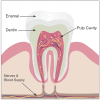Dental pulp stem cells for the study of neurogenetic disorders
- PMID: 28582499
- PMCID: PMC5886465
- DOI: 10.1093/hmg/ddx208
Dental pulp stem cells for the study of neurogenetic disorders
Abstract
Dental pulp stem cells (DPSC) are a relatively new alternative stem cell source for the study of neurogenetic disorders. DPSC can be obtained non-invasively and collected from long-distances remaining viable during transportation. These highly proliferative cells express stem cell markers and retain the ability to differentiate down multiple cell lineages including chondrocytes, adipocytes, osteoblasts, and multiple neuronal cell types. The neural crest origin of DPSC makes them a useful source of primary cells for modeling neurological disorders at the molecular level. In this brief review, we will discuss recent developments in DPSC research that highlight the molecular etiology of DPSC derived neurons and how they may contribute to our understanding of neurogenetic disorders.
© The Author 2017. Published by Oxford University Press. All rights reserved. For Permissions, please email: journals.permissions@oup.com.
Figures


References
-
- Liu Q., Spusta S.C., Mi R., Lassiter R.N.T., Stark M.R., Hoke A., Rao M.S., Zeng X. (2012) Human neural crest stem cells derived from human ESCs and induced pluripotent stem cells: induction, maintenance, and differentiation into functional Schwann cells. Stem Cells Transl. Med., 2012, 266–278. - PMC - PubMed
-
- Chen X., Gu Q., Wang X., Ma Q., Tang H., Yan X., Guo X., Yan H., Hao J., Zeng F. (2013) Directed neuronal differentiation of mouse embryonic and induced pluripotent stem cells and their gene expression profiles. Int. J. Mol. Med., 32, 25–34. - PubMed
Publication types
MeSH terms
Grants and funding
LinkOut - more resources
Full Text Sources
Other Literature Sources

